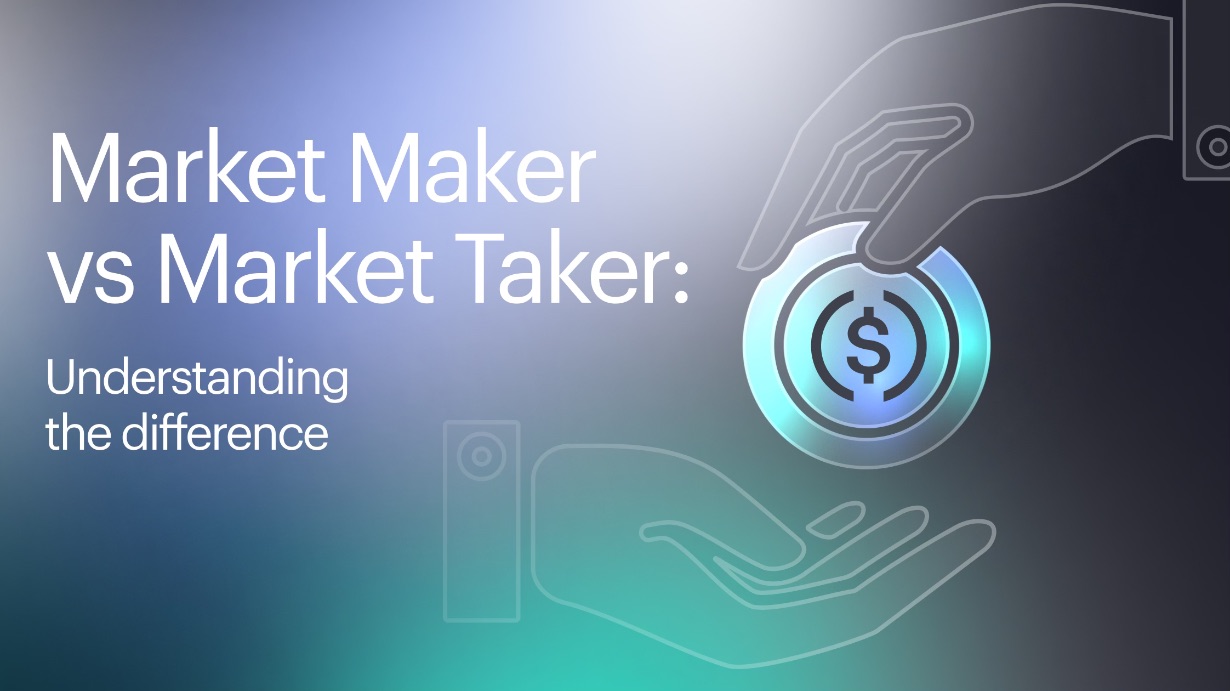
Modern financial and crypto markets rely on two fundamental roles: market makers and market takers. Understanding the market maker vs market taker dynamic is essential for anyone participating in digital asset trading. These roles not only determine how liquidity is created and consumed but also influence trading costs, price discovery and overall market stability. The market maker vs market taker comparison is especially relevant in crypto markets, where around‑the‑clock trading demands deep liquidity and efficient order execution.
As a market participant, recognising whether you are providing or consuming liquidity can help you optimise your trading outcomes. Market makers create opportunities for others by quoting both buy and sell prices, while market takers execute against those quotes. This interplay is central to a smoothly functioning trading environment, and it directly affects the fees you pay, the speed of execution and your exposure to market volatility. In the following sections, we explore these roles in depth, address common questions and provide guidance on choosing the right strategy.
Market Liquidity and the Bid‑Ask Spread
Before diving into individual roles, it’s helpful to understand market liquidity. Liquidity refers to how easily an asset can be bought or sold without causing a significant change in its price. A liquid market has plenty of buyers and sellers, producing a narrow bid‑ask spread—the difference between the highest bid and the lowest ask. In liquid markets, the bid ask spread is tight because buyers and sellers meet near the same current market price. Conversely, illiquid markets exhibit wider spreads and greater market volatility, making it harder to trade without experiencing slippage.
Order books are the mechanism exchanges use to record buy and sell orders. They list the prices and volumes at which traders are willing to transact, forming the foundation for market makers and market takers to interact. When an exchange’s order book is deep, meaning there are many existing orders at various price levels, traders can execute large orders without significantly moving the price. Hence, healthy market liquidity contributes to price stability, efficient trading and a vibrant crypto market.
Market Makers: Role and Responsibilities
What Is a Market Maker?
A market maker is a trader or institution that continuously quotes both a bid (buy) and an ask (sell) price for a financial instrument, thereby providing liquidity. Unlike speculators who aim to profit from short term price movements, market makers prioritise liquidity and earn from the bid ask spread. Market makers quote both buy and sell prices to ensure a counterparty is available for other traders. They act as liquidity providers on trading platforms, enabling other participants to trade easily even during volatile market conditions.
How Market Makers Work in Crypto Markets
Market makers generally use limit orders, which specify a specified price at which they are willing to buy or sell. One example describes a maker placing a buy limit order for five ETH at $3500 and a sell limit order at $3600, effectively creating a two‑sided market. By placing these buy and sell orders into the order book ahead of time, market makers “make” the market and allow traders to match those orders later.
The role market makers play isn’t limited to setting quotes. They must manage inventory risk, monitor market volatility and adapt to market dynamics. Holding positions exposes them to unexpected price swings, which is why they often employ sophisticated hedging strategies and risk management systems. On some exchanges, designated market makers are appointed to maintain orderly trading and ensure market stability.
Examples of Market Makers and Liquidity Providers
The crypto landscape features a number of notable crypto market makers. Firms such as Wintermute, GSR, Wincent and Flow Traders deploy advanced algorithms to provide liquidity across multiple exchanges. They stabilise prices, narrow the bid ask spread and help smaller platforms grow by seeding their order books. In decentralised finance (DeFi), liquidity can also come from an automated market maker (AMM). AMMs use smart contracts to create liquidity pools, allowing traders to swap tokens without a traditional order book.
Market Takers: Role and Priorities
What Is a Market Taker?
A market taker is any trader who executes against existing orders at the best available price. Instead of posting new quotes, takers “take” liquidity by accepting the prices quoted by makers. Sources emphasise that takers remove liquidity by executing orders immediately, often via market orders. In other words, market takers consume liquidity, filling orders that have been posted by others. Their priority is immediate execution, making this role attractive to traders who need to react quickly to market conditions or news.
How Market Takers Execute Orders
Market takers typically use market orders, instructions to buy or sell at the current market price. When a market order is submitted, the exchange matches it against the best available limit orders in the order book. If a trader uses a limit order with a price equal to or better than the existing orders, it may also execute immediately and be treated as a taker transaction. Therefore, immediate order execution is characteristic of market takers. They prioritise certainty and speed over securing the most favorable prices, which can result in slippage when large orders move the market prices.
Because they execute trades immediately and consume liquidity, takers often pay taker fees, which are generally higher than maker fees. Some exchanges charge takers between 0.1 % and 0.035 % depending on volume. In contrast, makers may pay lower or even zero fees.
Limit Orders vs Market Orders
Understanding order types is central to distinguishing market makers and takers. A limit order specifies a specified price at which you want to buy or sell. It sits on the order book until another trader matches it, making you a maker if it doesn’t execute immediately. Limit orders allow you to wait for the execution price you prefer, but there’s no guarantee the trade will fill. They are the primary tool used in market making to provide liquidity.
A market order, by contrast, instructs the exchange to buy or sell immediately at the current market price. Market orders prioritise immediate execution and are the hallmark of market takers. However, market orders can result in less favorable prices when liquidity is thin or volatility is high. Using the right order type depends on your trading strategy and whether you value price control over speed.
Maker‑Taker Fee Structures and Transaction Costs
One of the most noticeable differences in the maker taker model is the fee structure. Exchanges generate revenue by charging trading fees, and many offer different rates for makers and takers. Makers often receive rebates or pay lower fees because they provide liquidity, which enhances the attractiveness of the exchange. Some platforms waive maker fees entirely, acknowledging the value of liquidity.
Takers, on the other hand, face higher fees because their trades consume liquidity and can widen the bid ask spread. Fee structures vary significantly across exchanges, with some offering tiered pricing based on volume. Additionally, takers must contend with the transaction costs embedded in the spread and potential slippage. For active traders executing large orders, these costs can materially impact profitability.
Comparing Position Taking and Market Making
The distinction between position taking and market making revolves around intent. A position taker buys or sells an asset to profit from changes in its market value. This can involve long‑term investment or speculative trading strategy based on expected price appreciation or depreciation. Conversely, a market maker does not typically aim to bet on direction; instead, they earn from the bid ask spread by simultaneously quoting buy and sell prices. Their focus is on maintaining inventory balance and ensuring the market prices they quote remain competitive.
Position takers often hold assets for longer periods and may be exposed to broader market conditions and cycles. Market makers turn over their positions quickly, constantly adjusting quotes to manage risk. This difference explains why market making requires sophisticated systems and risk management, whereas position taking requires analysis of fundamentals and technical indicators.
Risks, Market Conditions and Volatility
Both market makers and takers face risks, although their nature differs. Market makers carry inventory, which exposes them to market volatility. Sudden price movements can erode their profits if they’re unable to offset positions quickly. Makers must monitor and adjust their quotes to maintain market stability and limit losses. In volatile periods, maintaining a two‑sided market can be challenging, and makers may widen spreads to compensate.
Market takers face risks associated with immediate execution. Large market orders in illiquid markets can lead to slippage, where the trade is executed at a less favorable price than expected. High market volatility can also increase taker fees and overall transaction costs. Both roles must assess market conditions—such as trading volume, order book depth and short‑term sentiment—to optimise their strategies.
Pros and Cons of Being a Market Maker
Market makers enjoy several advantages. They often pay lower trading fees or receive rebates. By narrowing the bid ask spread, they earn steady profits on each trade executed. Because they provide liquidity, makers contribute to efficient trading and may attract incentives from exchanges. Market makers also have greater control over their execution price since they set their own quotes.
However, there are drawbacks. Makers must manage multiple existing orders, and there’s a risk that these orders remain unfilled, leaving capital idle. Volatile market conditions can lead to holding assets longer than intended, exposing makers to price swings. Moreover, building an effective market making operation can be capital‑intensive and requires robust risk management and technology.
Pros and Cons of Being a Market Taker
For traders seeking immediate trades, the market taker role offers clear benefits. Takers receive immediate order execution, ensuring their trades are filled quickly. This is particularly valuable when reacting to news or when markets move swiftly. Taker orders are simple to place, and traders don’t need to manage multiple open positions.
Yet, these advantages come at a cost. Takers usually pay higher fees because they consume liquidity. They may experience slippage, especially when executing large orders or trading illiquid pairs. Since they accept the current market price, they have less control over the final execution price and may forego more favorable prices that could be achieved through patient order placement. In addition, takers may pay higher transaction fees on some platforms.
Frequently Asked Questions
What is the difference between a maker and a taker?
A maker places limit orders that add to the order book and provide liquidity, while a taker uses market orders or limit orders that match existing quotes and consume liquidity. Makers earn from the bid ask spread and often pay lower fees; takers prioritise speed and pay higher trading fees.
What is the difference between position taking and market making?
Position taking involves buying or selling an asset to profit from changes in its market value, while market making focuses on continuously quoting buy and sell prices to earn the spread. Position takers speculate on direction; market makers aim to keep markets liquid and stable.
Who is considered a market maker?
A market maker can be an individual trader, a brokerage firm or a specialist liquidity provider. On some exchanges, market makers include high‑frequency trading firms and individual traders placing strategic limit orders. In decentralised finance, anyone contributing to a liquidity pool acts as a liquidity provider.
What is an example of a market maker?
In the crypto industry, large trading firms and algorithmic liquidity providers are prominent crypto market makers that provide liquidity across multiple platforms. Some exchanges also appoint designated market makers to maintain orderly trading and ensure a steady flow of buy and sell orders. In DeFi, protocols that use an automated market maker perform a similar role by using liquidity pools.
Conclusion: Market Dynamics and Efficient Trading
The relationship between market makers and market takers is the cornerstone of efficient markets. Makers and takers together keep order books active, narrow the bid ask spread, and ensure traders can enter and exit positions with ease. Makers enhance market stability by continuously providing liquidity, while takers bring trading activity and volume, enabling price discovery. Without this symbiotic relationship, the crypto market would be less efficient, more volatile and less accessible.
Whether you choose to act as a maker, a taker or both, understanding their roles empowers you to navigate markets confidently. By considering fees, market conditions, order types and your own objectives, you can align your approach with the dynamics that underpin modern trading. As digital assets evolve, the maker taker model will continue to shape how participants interact, ensuring that markets remain liquid, fair and accessible.




.png)




















